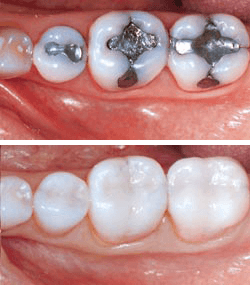 It is important to our dentist, Dr. Merrily Sandford, that we deliver excellent dental care that is free of hazardous materials that might negatively affect your health. If at any point you might have received a metal amalgam filling from another practice, we offer safe amalgam filling removal in Austin, Texas, to give your mouth a fresh start. To learn more, please give us a call today at 512-263-8284.
It is important to our dentist, Dr. Merrily Sandford, that we deliver excellent dental care that is free of hazardous materials that might negatively affect your health. If at any point you might have received a metal amalgam filling from another practice, we offer safe amalgam filling removal in Austin, Texas, to give your mouth a fresh start. To learn more, please give us a call today at 512-263-8284.
Safely Remove Your Amalgam Fillings
Dentists all over the world remove millions of amalgam fillings every day, without realizing the danger that comes from this dental procedure!
There typically isn’t any regard for the possible mercury exposure that can result from grinding the filling out of the tooth. Stories abound concerning patients having adverse reactions and getting sick following the removal of their amalgam fillings.
Many dentists claim they are Mercury-Free but in most cases that only refers to the fact that they do not place amalgam fillings and most do not realize the many hidden dangers of not removing the amalgam properly.
The Biological Dentist or true Mercury-Free Dentists of the world have been acutely aware of the excess exposure problem and have devised a number of strategies for reducing the amount of mercury exposure to both their patients and dental staff during amalgam removal.
Dr. Sandford and her Associates use the IAOMT & SMART approved protocol to remove Silver Mercury Fillings.
Don’t Grind and Keep It Cool
If you remove an old amalgam by slicing across it and dislodging big chunks, you will aerosolize less of the contents than if you grind it all away. If you keep it under a constant water spray while cutting, you will keep the temperature down, and reduce the vapor pressure within the mercury. Taking out fillings with a high-speed dental bur generates a cloud of particles, at least 65% of which are one micron or less in size. They can be inhaled and get deep into the lungs where the microscopic particles are broken down and the mercury is systemically absorbed within a few days. This mercury exposure can be as much as a hundred times greater than that from the vapor.
High Volume Evacuation Suction
Your best tool for removing mercury vapor and amalgam particulates from the operating field is your high volume evacuation (HVE). Keeping the suction next to the patient’s tooth until you are finished with the removal and clean-up process is necessary.

Rubber Dam
A rubber dam will help contain the majority of the debris of amalgam grinding, among its many other benefits. You must know that mercury vapor can diffuse right through the dam and some of the particulates will often sneak past it.
So always use a saliva ejector behind the dam to evacuate air that may contain mercury vapor.
As soon as the amalgams are out, remove the dam and thoroughly rinse the patient’s mouth before placing the new restorations. It can take as much as sixty seconds of rinsing to fully remove the mercury vapor. Search for gray particles. If there are particles on the back of the tongue, have the patient sit up and gargle.
Cover the Patient’s Skin
Covering the patient’s face with a barrier will prevent spattered amalgam particles from landing on the skin, or the eyes. The barrier can be as simple as a moist paper towel, or as elaborate as a surgical drape.
Nitrile Rubber Gloves
Mercury vapor can diffuse through latex and vinyl gloves, just as it can through latex and vinyl rubber dams. Nit-rile material is a more effective diffusion barrier, and while there are no nit-rile rubber dams available, nit-rile rubber gloves appear to better protect the dentist’s hands from a concentration of mercury vapor.
Control the Breathing Space
However efficient your HVE technique is, the air surrounding the operative field will fill up with a mercury vapor and amalgam particulate aerosol. Keeping the breathing space of the patient and dental staff free of contamination is the next priory
Supplemental Air
Provide the patient with piped–in air, so they do not have to breathe the air directly over the mouth during amalgam removal.
Respirators for the Staff
The typical paper hygienic masks that are in everyday use are of no benefit whatsoever for removing either amalgam particulates or mercury vapor from the air we breathe. The best protection for the dentist and the dental staff, from an industrial hygiene point of view, would be a positive pressure respirator.
Maintain Clean Air in the Operatory
Mercury vapor and amalgam particulates generated by removing amalgams are dispersed in the air of the operatory and are extracted in our office with a Dent-Air Vac.
